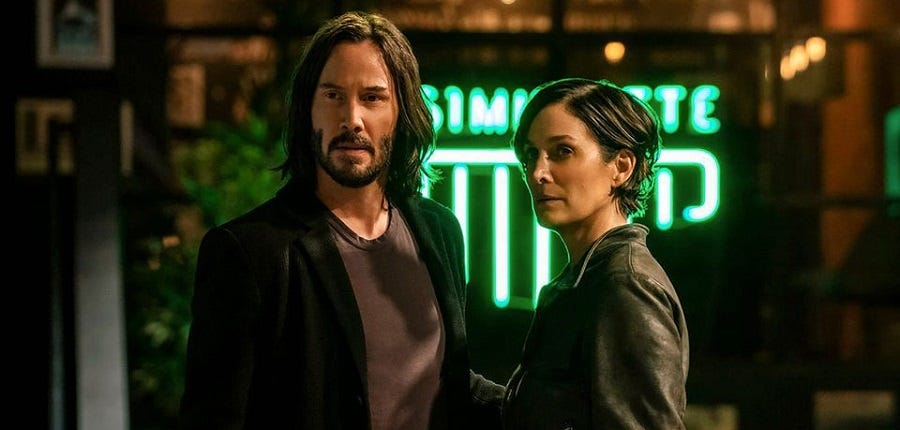Neo Realism
"The Matrix Resurrections" revisits sim city for a sequel that intentionally subverts itself.

The Nut Graf1: “The Matrix Resurrections” (in theaters and on HBO Max, **1/2 stars out of ****) offers the novel sight of a director deconstructing her biggest hit. For the more thoughtful fans of the series.

“The Matrix Resurrections” is something unusual: A reluctant sequel. An early scene has Neo (Keanu Reeves) back in the simulated reality of the title with no memory of having saved mankind over the course of three 20-year-old movies. Or, rather – stay with me here – in this new Matrix reality, he has sublimated those memories into the creation of three wildly successful videogames, also called “The Matrix” and also 20 years old. And now Warner Bros. wants a reboot videogame, with him or without him, and the hero’s beaten-down weariness at reviving past glories apparently mirrors the disgust that “Matrix” directors Lana and Lilly Wachowski felt when they heard that the real Warner Bros. was planning to go ahead with this very movie – with them or without them. (Since Lilly Wachowski had other commitments, her sister ended up directing “Resurrections” solo.) The entire sequence is a stiff middle finger to the suits in the front office as well as a moment so cubically meta that it just about eats its own tail.
Eventually, Neo gets his groove back – no, I won’t spoil anything in the way of details – but Reeves’ middle-aged exhaustion is part of the warp and weft of the new movie, much as it was in last year’s “Bill and Ted” reunion. With one exception, the action sequences in “Resurrections” are plentiful but perfunctory, as though Wachowski were fulfilling a contractual obligation. Instead, the movie’s pulse resides with the characters and the feelings that flow between them. This Neo doesn’t really care about being the Chosen One anymore. He just wants to get Trinity (Carrie-Anne Moss) out of that Instant Pot the machines keep humans in. Back in the Matrix, Neo and Trinity have never met yet they’re still somehow connected at a molecular level, and there’s a nice little coffee shop scene between the two as they puzzle hesitantly over their attraction – it’s a charged, emotionally erotic moment more real than anything else in the movie, in part because the two actors, both in their mid-50s, have some mileage on them.

Is Lana Wachowskis sabotaging her own film? Not really, but you can tell she’d rather spend time with the humans. Jada Pinkett Smith returns, under unfortunate old age make-up, as resistance leader Niobe, and there’s a new character, a blue-haired rebel named Bugs (Jessica Henwick) who more or less functions as the film’s Han Solo. The great guru Morpheus has been recast – or reconstituted, or something – as a younger figure played by the charismatic Yahya Abdul-Mateen II (HBO’s “Watchmen,” “The Trial of the Chicago 7”). The other rebels are given grace and individuality, while the chief antagonists are played by deft hams: Jonathan Groff (George III in “Hamilton”) as the rogue Agent Smith and Neil Patrick Harris as Neo’s cagey therapist. It’s the latter villain who speaks most mischievously of how this latest iteration of the Matrix has been designed to pander to consumers hooked on gunfights, explosions, and slo-mo “Bullet Time” — which is Lana Wachowski’s way of telling us what she’s not interested in.
There is a great deal of gunplay in “The Matrix Resurrections,” of course, and it may be intentionally funny that the bad guys shoot so many rounds without hitting a goddamn thing while the good guys hit their mark every time. The movie is violent but bloodless in a way that appears to be purposeful; the one scene where you actually feel the horror of what’s happening involves dozens of Matrix citizens throwing themselves off ledges and out of windows in an effort to “bomb” the heroes. Leaping off a precipice is a recurrent theme in this movie, and the people to trust are the ones who are most afraid to fall.

Another recurrent theme is the importance of choice and how, when presented with two options, there’s always the possibility of choosing a third. Look, either you care deeply about the “Matrix” movies – meaning you were probably between the ages of 15 and 30 when the first one came out – or they mean little to you. Or you’re like me and you find the whole series and its what-is-reality dorm-room philosophizing enjoyably silly. (It helps to be a Keanu fan, which we very much are in this house.) The first group stands to be perplexed by the new film, but casual fans may appreciate it as a way of dispensing with the whole blue pill/red pill nonsense and exploring the other avenues available. “The Matrix Resurrections” may be the first non-binary blockbuster.
If you enjoyed this edition of Ty Burr’s Watch List, please feel free to share it with friends.
If you’re not a paying subscriber and would like to sign up for additional postings and to join the discussions, here’s how:
If you’re already a paying subscriber, I thank you for your generous support.





